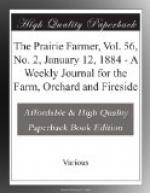She aims to set several hens and the incubator at the same time; when the eggs hatch the incubator ducklings are divided up among the hens; one hen will care for twenty ducklings until they are old enough to care for themselves. The eggs hatch well—those in the incubator quite as well as those under hens, and when the incubator ducklings are once mixed up with the others she finds it impossible to distinguish “which from ’tother.”
When the ducklings are ten or twelve hours old they are moved with the mother hen to coops and safety runs, which are placed in an orchard near the house. This orchard contains about four and a half acres, and the coops are scattered over it a few rods apart. On the side of the orchard that leads to the “pond lot,” the bottom board of the fence is a foot wide and comes close to the ground in order to keep the ducklings from taking to the water too early in life.
When the ducklings are four weeks old the hens are taken away, but the ducklings are kept in the orchard until they are six weeks old, or until they are well feathered on the breast and under part of their bodies, when they are turned into the pond lot, where they “take to the water like ducks.”
The pond lot contains nearly thirteen acres, five of which are covered with water. Originally, this lot was a piece of low, rocky, bushy pasture land, between two low ranges of hills. A stream of clear, sparkling water, a famous trout brook, ran through the center. The woman who proposed to raise ducks saw at once the advantage of such a situation, and had a dam constructed near the upper end of the lot, and later another was made lower down, so that the lot contained two large ponds. Where the fences which separate my friend’s land from that of her neighbor cross the stream, water-gates are put in, which keep the ducks from swimming out with the water; and the bottom boards of the fence around the rest of the lot keep them from getting out that way. Two well-trained dogs guard this lot at night, and woe to the two-footed or four-footed prowler who intrudes.
The duck houses are simply long, low sheds—with the exception of the one where the breeding stock is wintered, which is inclosed—placed on the slope a few rods back from the water. They were built of refuse lumber, and the cost was comparatively trifling. Connected with the house for the breeding-stock is a small yard where the ducks are shut in at night through the laying season. From the time when they are twelve hours old till within twenty-four hours of the time when they are killed for market, the ducklings are well fed with a great variety of food. From the first meal until they are turned into the pond lot they are fed every two hours between daylight and dark. “Little and often,” is the motto. Before they take to the water the ducklings are fed a little cooked meat once each day, and doubtless this ration of meat has much to do toward making the fine large ducks that my friend has a reputation for raising. After they are turned into the pond lot the ducklings are fed but three times a day till within two or three weeks of the time when they are to be marketed; then they are confined in the fattening yards and fed oftener.




